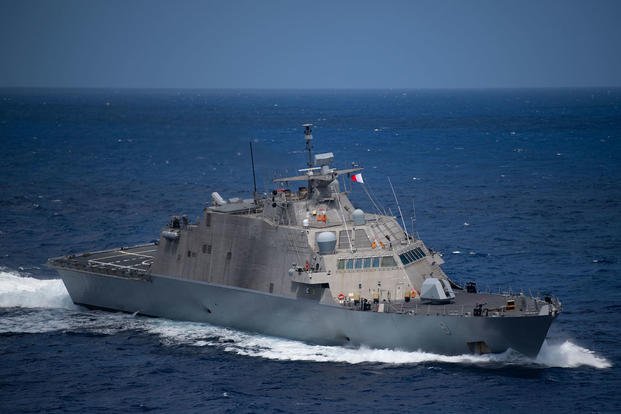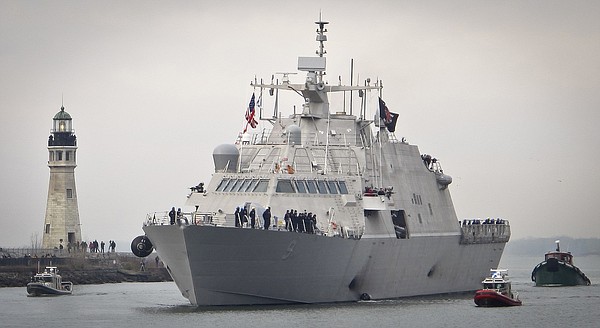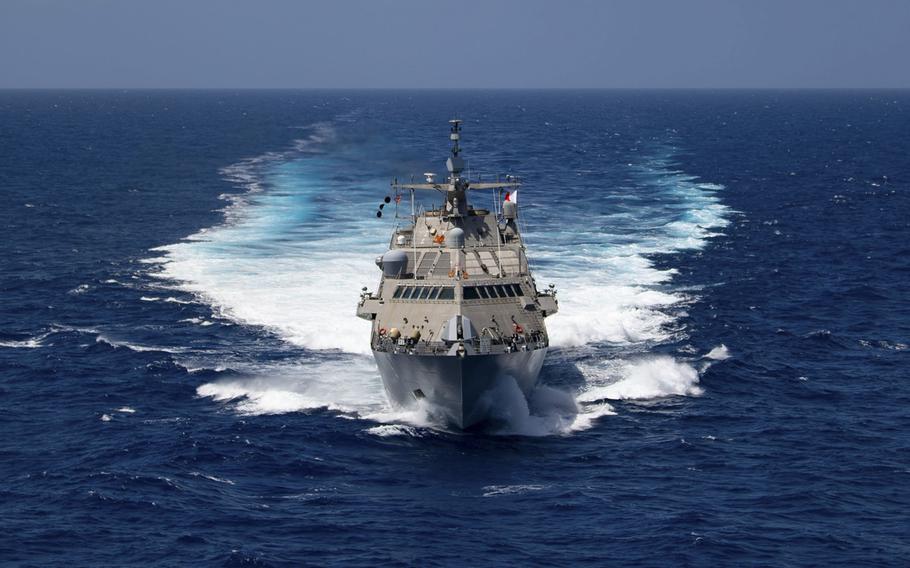Some 8,500 people turned out on Dec. 16, 2017, to watch the commissioning of the new $440 million USS Little Rock — draped in red, white and blue bunting — at Buffalo and Erie County Naval & Military Park.

The Freedom-class littoral combat ship USS Little Rock (LCS 9) underway in the Caribbean Sea, Feb. 16, 2020. (Marianne Guemo/U.S. Navy)
That now appears to have been the ship’s only bright moment.
Not even six years later, the USS Little Rock will be decommissioned on March 31 at Mayport Naval Station in Florida, where it is stationed.
The 387-foot-long vessel was imperiled from the start with significant design flaws that the Navy has concluded cannot be overcome.
U.S. Navy officials first announced at a media briefing almost a year ago that nine Freedom-class littoral combat ships would be decommissioned as part of the 2023 fiscal year budget.
“It’s somewhat of an embarrassment,” said Paul Marzello, the Naval Park’s executive director. “It was a happy moment, a proud moment on Dec. 16, 2017, and here it is five and a half years later, and she’s being decommissioned.”
“It is really a disappointment,” said Maurice Naylon, who chaired the commissioning committee. “We were so proud of the way we joined forces for this historic event, and it certainly put a nice sheen on Buffalo’s reputation.”

The Little Rock suffered a major failure at sea in 2020, six weeks after departing Mayport on its first deployment due to a flaw in the propulsion system, according to defensennews.com.
The nine Lockheed Martin-built high-speed vessels were designed to operate in shallow waters, and they were outfitted with some 8,000 computer sensors. All were hit with the propulsion problem. The ships will likely be scrapped or sunk to the bottom of an ocean — the fate of many decommissioned ships.
Rear Adm. John Gumbleton, the deputy assistant secretary of the Navy for budget, put the cost of the nine vessels — the newest of which was commissioned in 2020 — to be decommissioned at $4.5 billion, according to defensenews.com.
“That’s a lot of money going, literally, right down the drain,” said Mike Vogel, president of the Buffalo Lighthouse Association. “It was a very expensive ship that had all kinds of potential, and it was certainly an honor to have it commissioned here in Buffalo. It’s kind of heartbreaking to see it a little bit later being decommissioned and probably scrapped.”
The modular, reconfigurable ship was built to engage in surface warfare, hunt enemy submarines and eliminate mines. The ship had the rare capacity to change from one mission to another within 96 hours, and, in some cases, just 24 hours.
Its “plug and play” mission versatility also accommodated different weapon systems delivered at sea in steel cargo containers and lowered into the ship on a freight elevator, then maneuvered into place with overhead cranes and plugged into the ship’s computers.
Littoral combat ships can also maneuver in water just 13 1/2 feet deep, well below the 30 feet most naval ships require. That allows the ships to enter more ports, particularly in islands from Sri Lanka to the Philippines.

But the $762 billion defense budget for fiscal year 2023 included a request from the Navy to decommission 39 warships, including the nine Freedom-class littoral combat ships.
U.S. Rep. Steve Womack, who represents the Fayetteville, Ark., area, and takes pride in the two ships named for the state capital, told the Arkansas Democrat-Gazette in October that the littoral combat ship program represented “a sad chapter in the history of the Navy.”
“It’s sad that the USS Little Rock is one of those out of the Freedom class,” Womack said. “The Freedom class had more problems than the others, but the entire littoral combat ships program has suffered from a lot of setbacks.”
Deactivated ships are taken to one of three locations where mothballed fleets of naval vessels wait for disposal: Philadelphia, Bremerton, Wash., and Pearl Harbor, Hawaii.
The ships are often disassembled for the steel to be recycled. But that’s not always the case. Ships are also deliberately sunk, generally in locations where they can become artificial reefs to promote sea life, Vogel said.

The Navy’s Ship Donation Program decides if a vessel can be donated as a floating museum. But that rarely happens with ships with short lifespans. The Naval Park’s USS Little Rock, commissioned in 1945, served until 1976, six times the length of service of the newer namesake.
Marzello recalls fondly the commissioning of the newer ship. Former Secretary of the Navy Ray Mabus, who once served on the-now museum USS Little Rock, and 300 former crew members and relatives, were on hand for the historic occasion. So was Commander Paul Burkhart, a Western New York native who served as the new Little Rock’s first commander while under construction.
“We’re going to certainly take a look at any opportunity that could possibly bring her back to Buffalo as a museum ship,” Marzello said. “It would be an interesting opportunity to see a 1940s ship called the USS Little Rock versus a 2017 version.
“It didn’t look like much from the outside, but the inside was a technological marvel.”
Source: military.com








